House plants, like garden and greenhouse plants, are often bothered by a selection of tiny creatures with a taste for their sap, roots or foliage. While it is impossible to deal with each and every one of these little critters here, some of the most commonly found pests will be described separately. These common pests include:
As with problems of most kinds, prevention is usually better than cure, and there are a few things plant owners can do to minimise the risk of infestations.
New Plants and Pests
 While growers do their best to keep unwanted visitors away from the plants they sell, it is a well know fact that most infestations are introduced into existing plant collections by newly purchased plants.
While growers do their best to keep unwanted visitors away from the plants they sell, it is a well know fact that most infestations are introduced into existing plant collections by newly purchased plants.
To prevent giving such hitchhikers a lift (or bringing a fungus/ disease infected plant home), it is best to thoroughly inspect plants before buying them.
If a plant shows one or more of the signs listed below, it is best to leave it on the shelf and look for another, trouble free plant instead. Signs of infestation/ disease - usually noticed on leaves (often on the underside), flowers and near leaf axils - include:
- Brown/ dark spots
- Egg-cases and/ or discarded shells
- Fine webbing
- Grey fuzzy mould
- Holes
- Insects visible on plant
- Nibbled edges
- Powdery mildew (white dusty fungus)
- Silvery streaks
- Sticky patches of honeydew
- White, cotton-wool-like patches
Just to be on the safe side, it is also recommended to quarantine new plants for 4 to 6 weeks before placing them among existing collections. This also applies to plants that have spent the summer outside and are being returned indoors for the winter.
Routine Methods of Prevention
As pests will find all sorts of ways of getting at plants - and generally do not give a hoot whether a plant is old or new - it is obviously necessary to employ additional preventative measures. Such measures include:
- Carefully cleaning pots/ planters before using them to pot/ repot plants
- Using only sterile potting mixes (garden soil harbours all kinds of pests and diseases, and using it can prove to be disastrous)
- Promptly removing dead leaves, flowers and other debris
- Cleaning tools carefully after each use
- Bathing plants occasionally (with tepid, slightly soapy water and a soft cloth)
- Regular inspection (if necessary, using a magnifying glass)
- Immediately placing plants suspected of being infested under quarantine
- Plenty of fresh air, combined with the proper care/ feeding routine suitable for each plant, will ensure plants are healthy and more likely to resist/ overcome insect infestations.
Dealing with Infestations
 Even the most careful of owners will find that occasionally, some bug or another will make it through to their plants. Panic ye not, as the saying goes, because much can be done to get rid of them effectively - although it should be said that a speedy response is of utmost importance, because the longer an infestation is left, the more the infested plant will suffer and the more likely it is that the infestation will spread to other plants.
Even the most careful of owners will find that occasionally, some bug or another will make it through to their plants. Panic ye not, as the saying goes, because much can be done to get rid of them effectively - although it should be said that a speedy response is of utmost importance, because the longer an infestation is left, the more the infested plant will suffer and the more likely it is that the infestation will spread to other plants.
The first move is to get the infested plant as far away from other plants as possible. If the infestation is caught early, it is often possible to simply wipe the insects off with the help of a soft, damp cloth and a little soapy water. Some pests – in particular aphids - can be removed by giving the plant a good spraying (a jet of tepid water from a fine, but forceful seedling/ spray nozzle often works wonders).
In some cases, it is best to remove infested leaves, stems and/ or flowers (discarding them safely away from any plants). Serious infestation may also require use of slightly more drastic measures, but before reaching for chemical insecticides/ pesticides, it is worth trying one or more non-chemical grower's remedies.
Both adults and larvae of soil insects may occasionally be spotted milling around on the surface of soil after watering plants. Though mostly harmless, large populations may prune roots sufficiently to cause poor growth or wilting. Drenching the soil with an insecticidal soap solution usually clears the problem, and if all else fails, systemic insecticides/ pesticides will provide the desired effect.
Ants farming aphids, mealy bugs and other pests for honeydew are generally more helpful than harmful to plants, but may cause damage by burrowing into the soil to build nests and subsequently damaging the plant's root system. Here, too, a good drenching of the soil with insecticidal soap solutions should help, as will diazinon, malathion or systemic insecticides.
Non-Chemical Remedies
Because chemical treatments often have unwanted side-effects - such as killing helpful insects or, in some cases, even the plant they are supposed to rescue, for example - most growers have over time developed their own, usually most effective remedies.
As even these remedies can affect plants in different ways (some may, for example, affect the waxy coating of succulents like Echeveria, although these effects are typically temporary), it is best to try them out on a small area of one or two plants before treating every plant in the house.
Water, Oil and Soap Solutions
A small amount of light cooking oil (in particular Canola or sunflower oil), light horticultural oil or Neem oil, shaken in one litre of lukewarm water with just a couple of drops of dish or insecticidal soap (though dish detergent should not be used) will effectively smother most, if not all of the pests if sprayed thoroughly onto every part of the suffering plant. It is necessary to spray enough of the mix onto the plant to drench it - in other words, it should run off the plant.
The bottles and nozzles used to do this will need to be cleaned thoroughly afterwards, as the solidifying soap/ oil mix will otherwise clog the nozzle up.
Hot Pepper, Citrus and Garlic Sprays
 This will take a little more time and effort. Because hot pepper oils can cause serious skin irritations and are unbelievably vicious if they get into eyes, wearing gloves - and perhaps even goggles - while preparing and spraying this remedy is definitely recommended.
This will take a little more time and effort. Because hot pepper oils can cause serious skin irritations and are unbelievably vicious if they get into eyes, wearing gloves - and perhaps even goggles - while preparing and spraying this remedy is definitely recommended.
Ingredients include 3 hot peppers (green), 3 cloves of garlic (medium-sized) and one small onion (all of which should be pureed); 720 ml (24 fl oz, or 3 cups) of tepid water, and one tablespoon washing-up liquid. The pureed peppers, garlic and onion are spooned into a jar, to which the water and washing-up liquid are then added.
After standing for 24 hours, the pulp is strained out through cheesecloth, tights or stockings, and the liquid is transferred into a spray bottle (pump-action) to thoroughly spray infested plants.
Sucking insects will be smothered by the spray's washing-up liquid content, and chewing insects will be repelled by the scent and taste of the hot pepper, garlic and onion.
Another remedy working in a similar fashion consists of several crushed garlic cloves steeped in hot water (a few hours will do) and a couple of drops (added to the liquid after straining) of dish soap. Aphids can often be dealt with quite effectively with a spray made from the sliced rind of one lemon steeped in boiling water (600 ml/ 2.5 cups/ 1 pt).
Should all of these fail, an organic Neem oil insecticide may do the trick, although the seriousness of the infestation will determine how effective any of these remedies are. If things have been allowed to get really bad, chemical warfare may be the only remaining choice to prevent a whole collection of plants becoming infested and possibly destroyed.
Chemical Pest Control
Chemical pesticides should preferably only be used as a last resort. As some of the ingredients may be harmful to certain plants, helpful insects, pets and humans, it is vital to always read all instructions and warnings provided by manufacturers, as well as making sure the product is suitable not only for the type of pest to be dealt with, but also for the plant/s in question. If in doubt, it is better to ask for professional advice than to take the risk of killing plants.
Not every pesticide will kill every pest, and few pesticides will get rid of infestation through a single application. More often than not, repeated application is required, especially where pests with natural protection (egg cases, shells, and so on) against the effects of particular pesticides are concerned.
Treated plants should be kept under quarantine and regularly (at least once a week) checked for renewed signs of infestation. They should not be allowed to come into contact with other plants until absolutely sure the infestation has been completely removed.
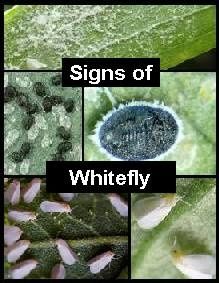 Clouds of adults rising during watering, or when moving the plant, as well as circles of eggs and/ or scale-like nymphs, which are easily spotted underneath leaves and on stems, are sure signs of whitefly infestations. Black areas caused by sooty mould attracted by the honeydew secreted by both adults and nymphs; slow/ stunted growth and wilting/ dropping foliage also indicate infestations.
Clouds of adults rising during watering, or when moving the plant, as well as circles of eggs and/ or scale-like nymphs, which are easily spotted underneath leaves and on stems, are sure signs of whitefly infestations. Black areas caused by sooty mould attracted by the honeydew secreted by both adults and nymphs; slow/ stunted growth and wilting/ dropping foliage also indicate infestations. 



 Also known as storm flies, thunder blights, thunder bugs or thunder flies, thrips have a slender, cigar-shaped body typically ranging from 0.5 to 1 mm (0.02 to 0.04 in) in length, although predatory thrips can grow to lengths of 14 mm (0.55 in).
Also known as storm flies, thunder blights, thunder bugs or thunder flies, thrips have a slender, cigar-shaped body typically ranging from 0.5 to 1 mm (0.02 to 0.04 in) in length, although predatory thrips can grow to lengths of 14 mm (0.55 in).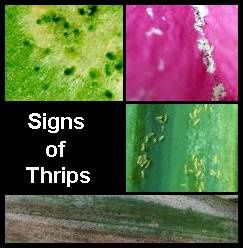 Because thrips rasp into flower petals and leaves to get at the sap, leaves and petals often appear distorted and feature visible scars. Thrips often also leave visible dark spots on flower petals and silvery streaks on foliage. In addition, it may be possible to detect the movement of congregations of larvae on the soil.
Because thrips rasp into flower petals and leaves to get at the sap, leaves and petals often appear distorted and feature visible scars. Thrips often also leave visible dark spots on flower petals and silvery streaks on foliage. In addition, it may be possible to detect the movement of congregations of larvae on the soil. Spider mites belong to the mite (Acari) family of Tetranychidae, a family including around 1,200 species. Known to feed on hundreds of different plant-species by puncturing plant cells using their mouth-parts, which are needle-sharp, they can quickly destroy a plant before moving on to the next host.
Spider mites belong to the mite (Acari) family of Tetranychidae, a family including around 1,200 species. Known to feed on hundreds of different plant-species by puncturing plant cells using their mouth-parts, which are needle-sharp, they can quickly destroy a plant before moving on to the next host. Only regular inspections with a magnifying glass will reveal an infestation within its earlier stages. Fine webbing under leaves, or between stems and leaves and a bronzed, washed appearance of the plant indicate heavy infestations. By this time, controlling the infestation is often extremely difficult, if not downright impossible.
Only regular inspections with a magnifying glass will reveal an infestation within its earlier stages. Fine webbing under leaves, or between stems and leaves and a bronzed, washed appearance of the plant indicate heavy infestations. By this time, controlling the infestation is often extremely difficult, if not downright impossible. The scale insect, often simply known as scale, is a limpet-like sap sucking pest likely to infest just about any greenhouse, ornamental or house plant, as well as fruits and even vegetables, although some of its many species seem to have developed a particular taste for plants belonging to the fern and fig (ficus) families.
The scale insect, often simply known as scale, is a limpet-like sap sucking pest likely to infest just about any greenhouse, ornamental or house plant, as well as fruits and even vegetables, although some of its many species seem to have developed a particular taste for plants belonging to the fern and fig (ficus) families.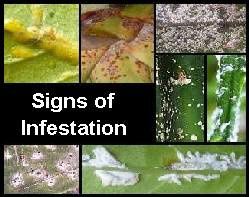 Scale infestations can be detected by patches of the fibrous white wax; patches of honeydew and/ or a blackened appearance of leaves/ stems due to sooty mould attracted by the honeydew; discard outer coverings (shell-like scales/ bumps), and, of course, insect activity.
Scale infestations can be detected by patches of the fibrous white wax; patches of honeydew and/ or a blackened appearance of leaves/ stems due to sooty mould attracted by the honeydew; discard outer coverings (shell-like scales/ bumps), and, of course, insect activity. Mealy bugs are common, sap sucking pests that thrive especially well in warm conditions. Although they will infest a whole list of house plants - as well as greenhouse plants - they have developed a particular taste for begonias, coleus, African violets, cacti and succulents. They are active and will continually breed all year round, and tend to live in clusters, usually in protected parts - like leaf sheaths and axils, between twining stems or closely layered leaves, or underneath loose pieces of bark - of plants.
Mealy bugs are common, sap sucking pests that thrive especially well in warm conditions. Although they will infest a whole list of house plants - as well as greenhouse plants - they have developed a particular taste for begonias, coleus, African violets, cacti and succulents. They are active and will continually breed all year round, and tend to live in clusters, usually in protected parts - like leaf sheaths and axils, between twining stems or closely layered leaves, or underneath loose pieces of bark - of plants. Specks or patches of fluffy white wax are typically the first sign of a mealy bug infestation. Both the females and their orange-pink eggs can be found below this substance. Accumulations of honeydew may also be visible, in particular if the infestation is heavy. In this case, blackened patches of sooty mould, which is attracted by the honeydew, may also be present. Root-feeding mealy bugs can be detected by easing the plant out of its container and looking for the tell-tale white mass among the roots. Mealy bug activity may also cause loss of vigour in the plant, as well as stunted growth and prematurely dropping leaves.
Specks or patches of fluffy white wax are typically the first sign of a mealy bug infestation. Both the females and their orange-pink eggs can be found below this substance. Accumulations of honeydew may also be visible, in particular if the infestation is heavy. In this case, blackened patches of sooty mould, which is attracted by the honeydew, may also be present. Root-feeding mealy bugs can be detected by easing the plant out of its container and looking for the tell-tale white mass among the roots. Mealy bug activity may also cause loss of vigour in the plant, as well as stunted growth and prematurely dropping leaves. Fungus Gnats, which belong to the order of Diptera, look similar to mosquitoes, are a nuisance and can cause serious havoc on plants, but are harmless to people and animals. Around 2 to 3 mm (1/16 to 1/8 in) long, their delicate bodies are black and feature greyish-transparent wings, antennae and thin legs. In spite of their wings, they can hardly fly and typically crawl or or hover just above soil/ window sills.
Fungus Gnats, which belong to the order of Diptera, look similar to mosquitoes, are a nuisance and can cause serious havoc on plants, but are harmless to people and animals. Around 2 to 3 mm (1/16 to 1/8 in) long, their delicate bodies are black and feature greyish-transparent wings, antennae and thin legs. In spite of their wings, they can hardly fly and typically crawl or or hover just above soil/ window sills.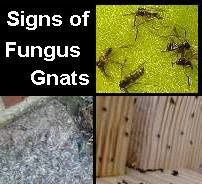 Because fungus gnats tend to be drawn to sources of light, large groups can often be spotted near doors and windows. On the plant itself, they are usually only visible when disturbed by watering or blowing on the plant. The adults typically do not feed on the plant, but their larvae, which remain invisible in the soil, feed on organic matter - including the plant's feeder roots and delicate root hairs - within the soil. As a result, the plant loses its vigour, growth is poor and the plant wilts. Eventually, foliage turns yellow and drops off.
Because fungus gnats tend to be drawn to sources of light, large groups can often be spotted near doors and windows. On the plant itself, they are usually only visible when disturbed by watering or blowing on the plant. The adults typically do not feed on the plant, but their larvae, which remain invisible in the soil, feed on organic matter - including the plant's feeder roots and delicate root hairs - within the soil. As a result, the plant loses its vigour, growth is poor and the plant wilts. Eventually, foliage turns yellow and drops off. Often simply referred to as green fly or black fly, these soft-bodied, 1 to 7 mm (up to about 1/4 in) long sap sucking insects actually include a variety of species. Typically pear-shaped and featuring long legs, some of these species are wingless, while others have wings. Colours vary from pink, black and yellow to white, red, green or mottled, and some of them - such as, for instance, the Woolly Beech Aphid and the Woolly Aphid - are often confused with scale insects, whitefly and mealy bugs, because they tend to cover themselves in the same fluffy, waxy white secretions.
Often simply referred to as green fly or black fly, these soft-bodied, 1 to 7 mm (up to about 1/4 in) long sap sucking insects actually include a variety of species. Typically pear-shaped and featuring long legs, some of these species are wingless, while others have wings. Colours vary from pink, black and yellow to white, red, green or mottled, and some of them - such as, for instance, the Woolly Beech Aphid and the Woolly Aphid - are often confused with scale insects, whitefly and mealy bugs, because they tend to cover themselves in the same fluffy, waxy white secretions. Typically attacking new plant growth, aphids can be found on house plants' growing tips, leaf axils, leaves (mainly on the underside) and flower buds. In addition to the actual insects, patches of honeydew and larvae, it is frequently also possible to spot accumulating cast off skins (white) on leaves' upper sides.
Typically attacking new plant growth, aphids can be found on house plants' growing tips, leaf axils, leaves (mainly on the underside) and flower buds. In addition to the actual insects, patches of honeydew and larvae, it is frequently also possible to spot accumulating cast off skins (white) on leaves' upper sides.
 Even the most careful of owners will find that occasionally, some bug or another will make it through to their plants. Panic ye not, as the saying goes, because much can be done to get rid of them effectively - although it should be said that a speedy response is of utmost importance, because the longer an infestation is left, the more the infested plant will suffer and the more likely it is that the infestation will spread to other plants.
Even the most careful of owners will find that occasionally, some bug or another will make it through to their plants. Panic ye not, as the saying goes, because much can be done to get rid of them effectively - although it should be said that a speedy response is of utmost importance, because the longer an infestation is left, the more the infested plant will suffer and the more likely it is that the infestation will spread to other plants. This will take a little more time and effort. Because hot pepper oils can cause serious skin irritations and are unbelievably vicious if they get into eyes, wearing gloves - and perhaps even goggles - while preparing and spraying this remedy is definitely recommended.
This will take a little more time and effort. Because hot pepper oils can cause serious skin irritations and are unbelievably vicious if they get into eyes, wearing gloves - and perhaps even goggles - while preparing and spraying this remedy is definitely recommended.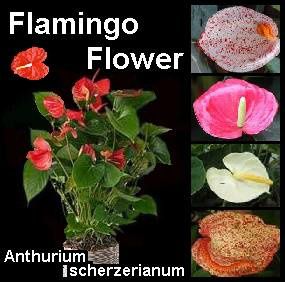 Botanical Name: Anthurium scherzerianum
Botanical Name: Anthurium scherzerianum  Water: To keep Anthurium scherzerianum well and happy, its soil should be kept evenly moist - though never soggy, as this will also result in yellow leaves - throughout the year.
Water: To keep Anthurium scherzerianum well and happy, its soil should be kept evenly moist - though never soggy, as this will also result in yellow leaves - throughout the year. 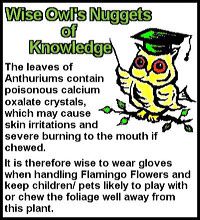 It also needs to be kept quite warm and, although it tolerates temperatures between 18 and 24 degrees C (65 to 75 degrees F), it does best within a constant temperature of 21 degrees C (70 degrees F). Drafts and temperatures below 10 degrees C (60 degrees F) should be avoided at all cost, because they will cause the plant's leaves to go yellow, as will over-watering.
It also needs to be kept quite warm and, although it tolerates temperatures between 18 and 24 degrees C (65 to 75 degrees F), it does best within a constant temperature of 21 degrees C (70 degrees F). Drafts and temperatures below 10 degrees C (60 degrees F) should be avoided at all cost, because they will cause the plant's leaves to go yellow, as will over-watering.  If seeds are used for propagation, it is essential to ensure they are fresh and still moist, as old, dry seeds simply will not germinate. Each seed should be placed into its own 10 cm (4 in) pot, which should then be covered with a mason jar in order to maintain high humidity. The temperature of the growing medium should be kept constant at 26.67 degrees C (80 degrees F) until germination - which should take 20 to 30 days - is complete.
If seeds are used for propagation, it is essential to ensure they are fresh and still moist, as old, dry seeds simply will not germinate. Each seed should be placed into its own 10 cm (4 in) pot, which should then be covered with a mason jar in order to maintain high humidity. The temperature of the growing medium should be kept constant at 26.67 degrees C (80 degrees F) until germination - which should take 20 to 30 days - is complete. 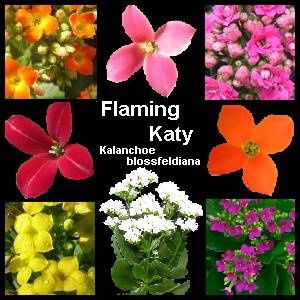 Botanical Name: Kalanchoe blossfeldiana
Botanical Name: Kalanchoe blossfeldiana  Temperatures: Average temperatures should range between 16 and 24 degrees C (60 to 75 degrees F) for Flaming Katy plants.
Temperatures: Average temperatures should range between 16 and 24 degrees C (60 to 75 degrees F) for Flaming Katy plants.  Although quite thick and apparently sturdy, these leaves are quite brittle in reality, and need to be handled with care to prevent their tips breaking off.
Although quite thick and apparently sturdy, these leaves are quite brittle in reality, and need to be handled with care to prevent their tips breaking off.  Around 6 to 8 weeks later, the first buds should start appearing, at which point normal care - keeping the soil just moist and feeding monthly - may be resumed. Even if flowering is not as abundant - and perhaps a little more erratic - than the first time round, the plant's attractive foliage still makes it worth keeping.
Around 6 to 8 weeks later, the first buds should start appearing, at which point normal care - keeping the soil just moist and feeding monthly - may be resumed. Even if flowering is not as abundant - and perhaps a little more erratic - than the first time round, the plant's attractive foliage still makes it worth keeping.